Bandgap-Tuned 2D Boron Nitride/Tungsten Nitride Nanocomposites for Development of High-Performance Deep Ultraviolet Selective Photodetectors
Abstract
1. Introduction
2. Experimental Details
3. Results and Discussion
3.1. Basic Characterization of Nanocomposite Materials
3.2. Fabrication of BN–WN-Based Prototype and Characterizations of Its Basic Electrical Properties
3.3. Bias Voltage Effect on Response to Light Radiation
3.4. Spectral Responses to UV Radiations
3.5. Time Response
3.6. Temperature Effect
4. Conclusions
Author Contributions
Funding
Acknowledgments
Conflicts of Interest
References
- Hai, Z.; Akbari, M.K.; Xue, C.; Xu, H.; Hyde, L.; Zhuiykov, S. Wafer-scaled monolayer WO3 windows ultra-sensitive, extremely-fast and stable UV-A photodetection. Appl. Surf. Sci. 2017, 405, 169–177. [Google Scholar] [CrossRef]
- Alenizi, M.R.; Henley, S.J.; Silva, S. On-chip Fabrication of High Performance Nanostructured ZnO UV Detectors. Sci. Rep. 2015, 5, 8516. [Google Scholar] [CrossRef] [PubMed]
- Agrawal, J.; Dixit, T.; Palani, I.; Singh, V. Systematic investigations on the effect of prolong UV illumination on optoelectronic properties of ZnO honeycomb nanostructures. Scr. Mater. 2019, 163, 1–4. [Google Scholar] [CrossRef]
- Liu, Z.; Li, F.; Li, S.; Hu, C.; Wang, W.; Wang, F.; Lin, F.; Wang, H. Fabrication of UV photodetector on TiO2/diamond film. Sci. Rep. 2015, 5, 14420. [Google Scholar] [CrossRef]
- Velazquez, R.; Aldalbahi, A.; Rivera, M.; Feng, P. Fabrications and application of single crystalline GaN for high-performance DUV photodetectors. AIP Adv. 2016, 6, 85117. [Google Scholar] [CrossRef]
- Dahal, R.; Li, J.; Majety, S.; Pantha, B.N.; Cao, X.K.; Lin, J.Y.; Jiang, H.X. Epitaxially grown semiconducting hexagonal boron nitride as a deep ultraviolet photonic material. Appl. Phys. Lett. 2011, 98, 211110. [Google Scholar] [CrossRef]
- Laksana, C.P.; Chen, M.-R.; Liang, Y.L.; Tzou, A.-J.; Kao, H.-L.; Jeng, E.S.; Chen, J.S.C.; Chen, H.-G.; Jian, S.-R. Deep-UVsensors based on SAW oscillators using low-temperature-grown AlN films on sapphires. IEEE Trans. Ultrason. Ferroelectr. Freq. Control 2011, 58, 1688–1693. [Google Scholar] [CrossRef]
- Rivera, M.; Velázquez, R.; Aldalbahi, A.; Zhou, A.; Feng, P.X. UV photodetector based on energy bandgap shifted hexagonal boron nitride nanosheets for high-temperature environments. J. Phys. D Appl. Phys. 2018, 51, 045102. [Google Scholar] [CrossRef]
- Aldalbahi, A.; Li, E.; Rivera, M.; Velázquez, R.; Altalhi, T.; Peng, X.; Feng, P.X. A new approach for fabrications of SiC based photodetectors. Sci. Rep. 2016, 6, 23457. [Google Scholar] [CrossRef]
- Toda, T.; Hata, M.; Nomura, Y.; Ueda, Y.; Sawada, M.; Shono, M. Operation at 700 °C of 6H-SiC UV Sensor Fabricated Using N+Implantation. Jpn. J. Appl. Phys. 2003, 43, L27–L29. [Google Scholar] [CrossRef]
- Lin, C.R.; Wei, D.H.; Bendao, M.K.; Chen, W.E.; Liu, T.Y. Development of High-Performance UV Detector Using Nanocrystalline Diamond Thin Film. Int. J. Photoenergy 2014, 2014, 1–8. [Google Scholar] [CrossRef]
- Pace, E.; de Sio, A. Innovative diamond photo-detectors for UV astrophysics. Mem. Soc. Astron. Ital. Suppl. 2010, 14, 84. [Google Scholar]
- Hou, M.; So, H.; Suria, A.J.; Yalamarthy, A.S.; Senesky, D.G. Suppression of Persistent Photoconductivity in AlGaN/GaN Ultraviolet Photodetectors Using In Situ Heating. IEEE Electron Device Lett. 2016, 38, 56–59. [Google Scholar] [CrossRef]
- Moustakas, T.D.; Paiella, R. Optoelectronic device physics and technology of nitride semiconductors from the UV to the terahertz. Rep. Prog. Phys. 2017, 80, 106501. [Google Scholar] [CrossRef] [PubMed]
- Aldalbahi, A.; Zhou, A.F.; Tan, S.; Feng, X.; Ali, A.; Andrew, F.Z.; Susheng, T.; Xianping, F. Fabrication, Characterization and Application of 2D Boron Nitride Nanosheets Prepared by Pulsed Laser Plasma Deposition. Rev. Nanosci. Nanotechnol. 2016, 5, 79–92. [Google Scholar] [CrossRef]
- Benmoussa, A.; Soltani, A.; Schuhle, U.; Haenen, K.; Chong, Y.; Zhang, W.; Dahal, R.; Lin, J.; Jiang, H.; Barkad, H.; et al. Recent developments of wide-bandgap semiconductor based UV sensors. Diam. Relat. Mater. 2009, 18, 860–864. [Google Scholar] [CrossRef]
- Lee, S.H.; Bin Kim, S.; Moon, Y.-J.; Kim, S.M.; Jung, H.J.; Seo, M.S.; Lee, K.M.; Kim, S.-K.; Lee, S.W. High-Responsivity Deep-Ultraviolet-Selective Photodetectors Using Ultrathin Gallium Oxide Films. ACS Photon 2017, 4, 2937–2943. [Google Scholar] [CrossRef]
- Qian, L.; Wang, Y.; Wu, Z.; Sheng, T.; Liu, X. β-Ga2O3 solar-blind deep-ultraviolet photodetector based on annealed sapphire substrate. Vacuum 2017, 140, 106–110. [Google Scholar] [CrossRef]
- Jin, Z.; Gao, L.; Zhou, Q.; Wang, J. High-performance flexible ultraviolet photoconductors based on solution-processed ultrathin ZnO/Au nanoparticle composite films. Sci. Rep. 2014, 4, 4268. [Google Scholar] [CrossRef]
- Wu, Z.; Bai, G.; Qu, Y.; Guo, D.; Li, L.; Hao, J.; Tang, W. Deep ultraviolet photoconductive and near-infrared luminescence properties of Er3+-doped ?-Ga2O3 thin films. Appl. Phys. Lett. 2016, 108, 211903. [Google Scholar] [CrossRef]
- Sajjad, M.; Peng, X.; Chu, J.; Zhang, H.; Feng, P. Design and installation of a CO2-pulsed laser plasma deposition system for the growth of mass product nanostructures. J. Mater. Res. 2013, 28, 1747–1752. [Google Scholar] [CrossRef]
- Feng, P.X.; Wang, X.P.; Zhang, H.X.; Yang, B.Q.; Wang, Z.-B.; González-Berríos, A.; Morell, G.; Weiner, B. Study of the structural evolutions of crystalline tungsten oxide films prepared using hot-filament CVD. J. Phys. D Appl. Phys. 2007, 40, 5239–5245. [Google Scholar] [CrossRef]
- Zhang, H.X.; Yang, B.Q.; Feng, P.X. Ambient Pressure Synthesis of Nanostructured Tungsten Oxide Crystalline Films. J. Nanomater. 2008, 2008, 1–5. [Google Scholar] [CrossRef]
- Chen, S.F.; Aldalbahi, A.; Feng, P.X. Nanostructured Tungsten Oxide Composite for High-Performance Gas Sensors. Sensors 2015, 15, 27035–27046. [Google Scholar] [CrossRef] [PubMed]
- Mohamed, S.H.; Anders, A. Structural, optical, and electrical properties of WOx(Ny) films deposited by reactive dual magnetron sputtering. Surf. Coat. Technol. 2006, 201, 2977–2983. [Google Scholar] [CrossRef]
- Aldalbahi, A.; Rivera, M.; Rahaman, M.; Zhou, A.F.; Alzuraiqi, W.M.; Feng, P. High-Performance and Self-Powered Deep UV Photodetectors Based on High Quality 2D Boron Nitride Nanosheets. Nanomaterials 2017, 7, 454. [Google Scholar] [CrossRef] [PubMed]
- Aldalbahi, A.; Zhou, A.F.; Feng, P. Variations of crystalline structure and electrical properties of single crystalline atomic thin boron nitride sheets. Sci. Rep. 2015, 5, 16703. [Google Scholar] [CrossRef]
- Feng, P.X.; Aldalbahi, A. A compact design of a characterization station for far UV photodetectors. Rev. Sci. Instrum. 2018, 89, 015001. [Google Scholar] [CrossRef]
- Rivera, M.; Velázquez, R.; Aldalbahi, A.; Zhou, A.F.; Feng, P. High Operating Temperature and Low Power Consumption Boron Nitride Nanosheets Based Broadband UV Photodetector. Sci. Rep. 2017, 7, 42973. [Google Scholar] [CrossRef]
- Zhou, A.; Aldalbahi, A.; Feng, P. Vertical metal-semiconductor-metal deep UV photodetectors based on hexagonal boron nitride nanosheets prepared by laser plasma deposition. Opt. Mater. Express 2016, 6, 3286. [Google Scholar] [CrossRef]
- Chen, X.; Liu, K.; Zhang, Z.; Wang, C.; Li, B.; Zhao, H.; Zhao, D.; Shen, D. Self-Powered Solar-Blind Photodetector with Fast Response Based on Au/β-Ga2O3 Nanowires Array Film Schottky Junction. ACS Appl. Mater. Interfaces 2016, 8, 4185–4191. [Google Scholar] [CrossRef]
- Mendoza, F.; Makarov, V.I.; Hidalgo, A.; Weiner, B.; Morell, G. Ultraviolet photosensitivity of sulfur-doped micro- and nano-crystalline diamond. J. Appl. Phys. 2011, 109, 114904. [Google Scholar] [CrossRef]
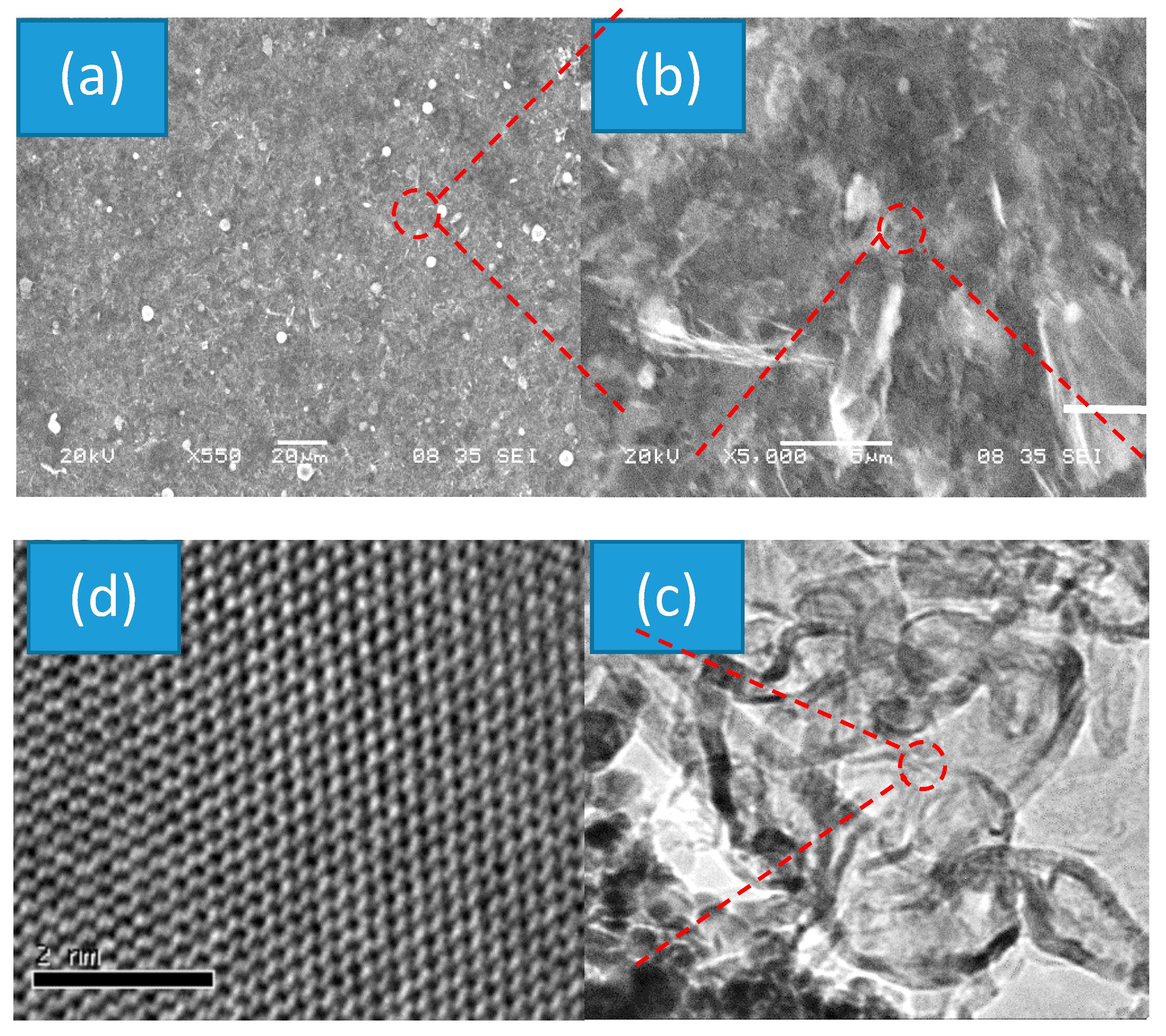


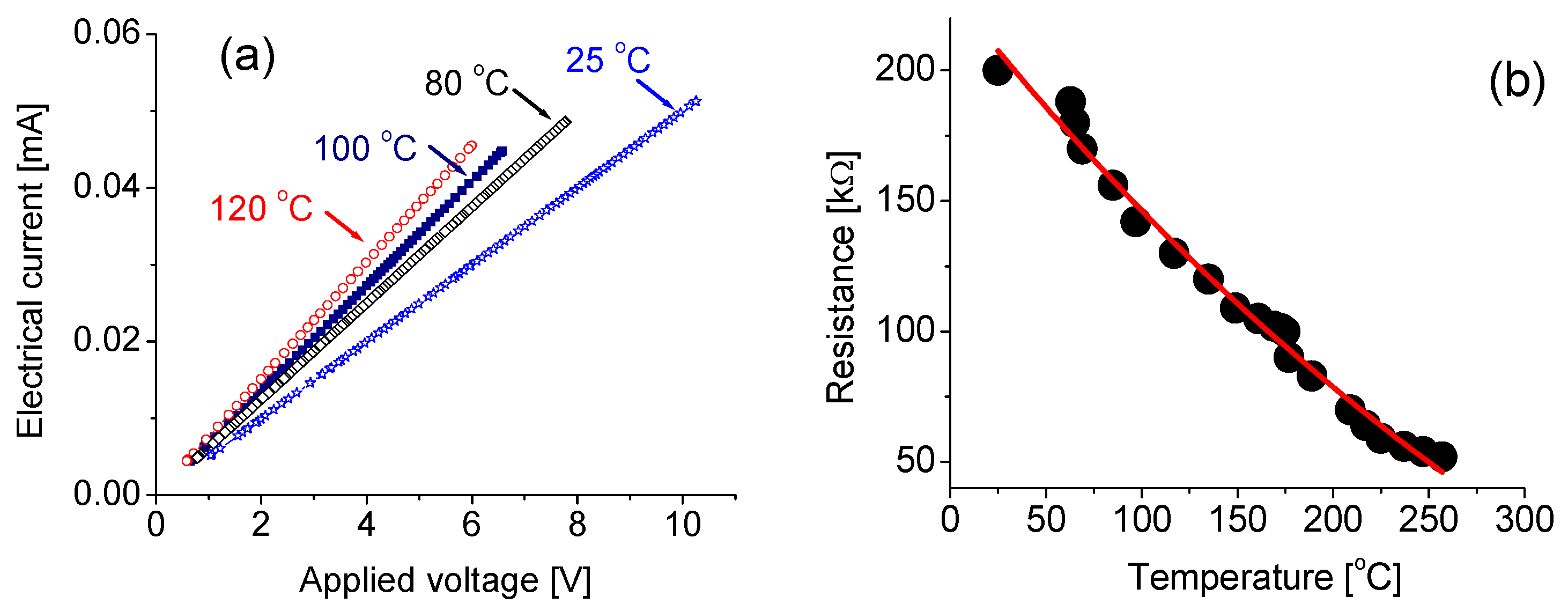
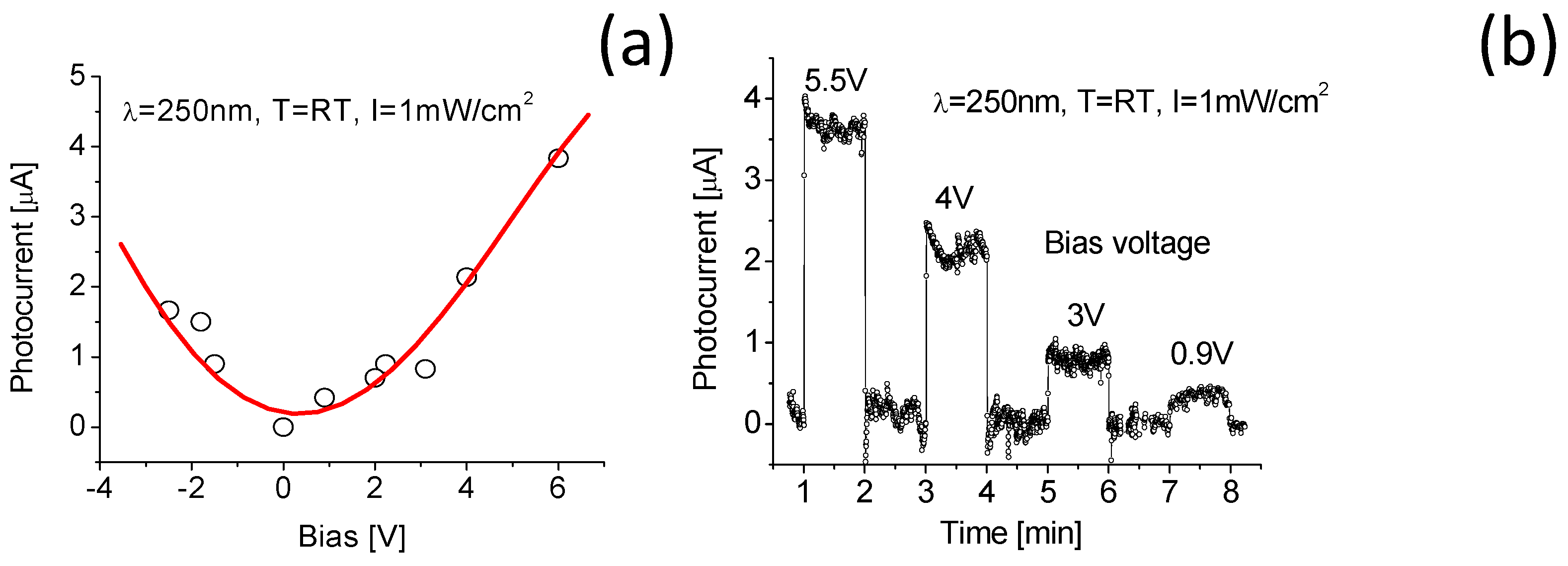
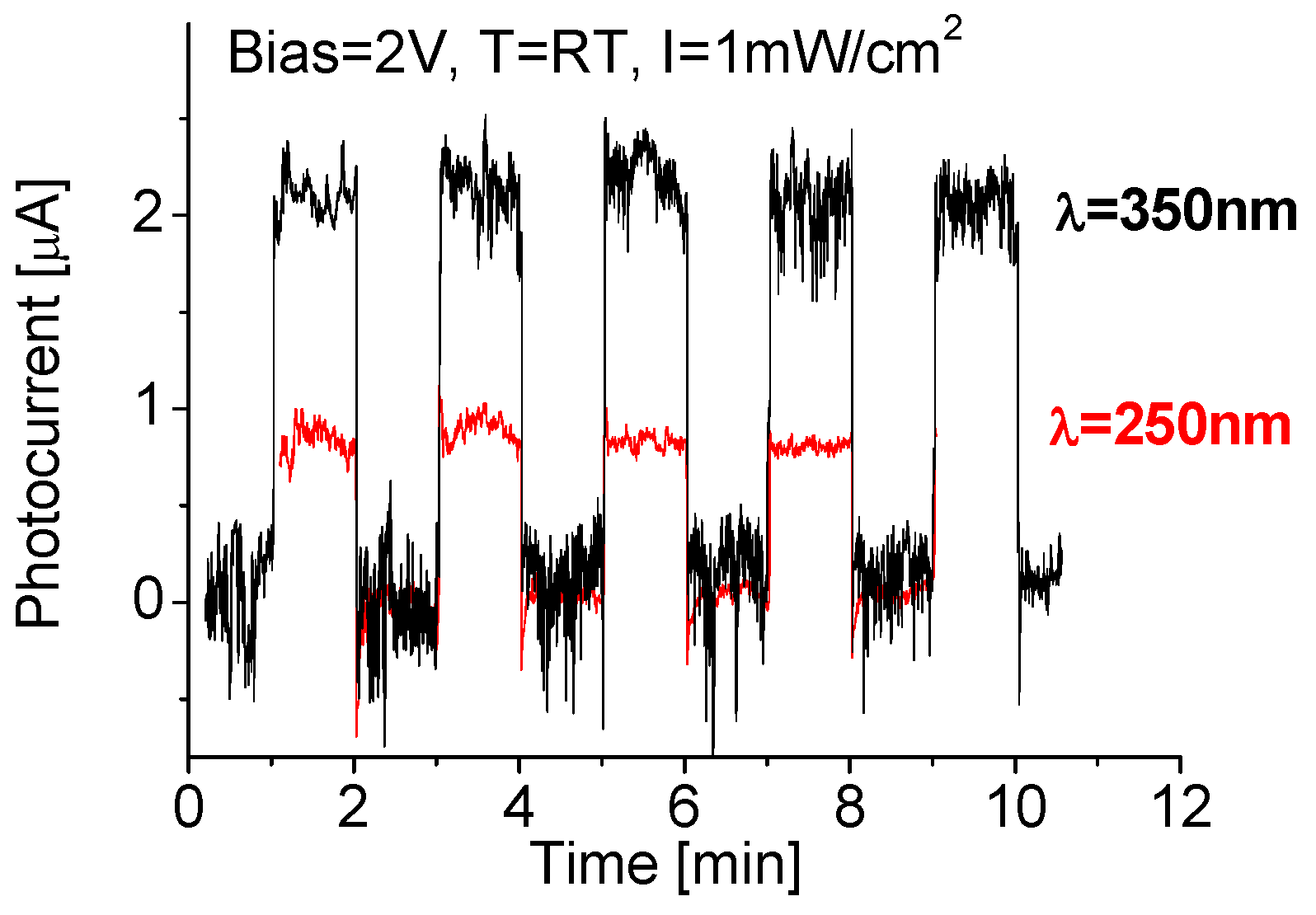
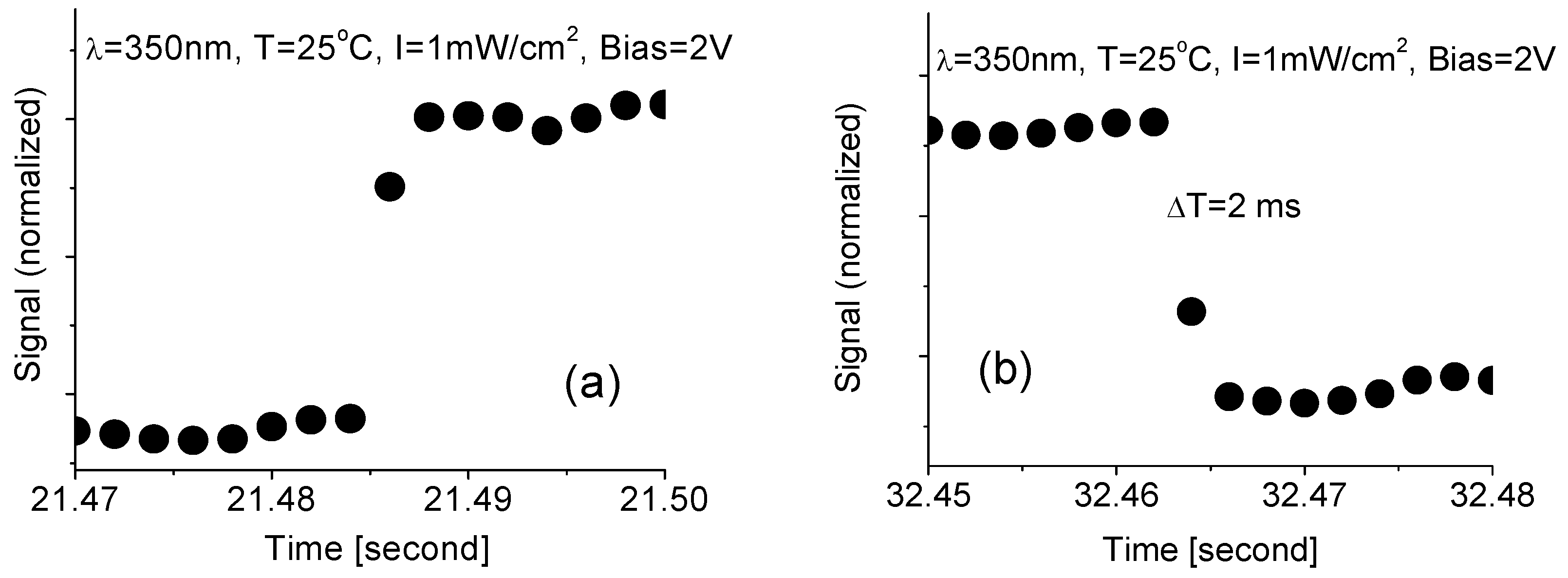
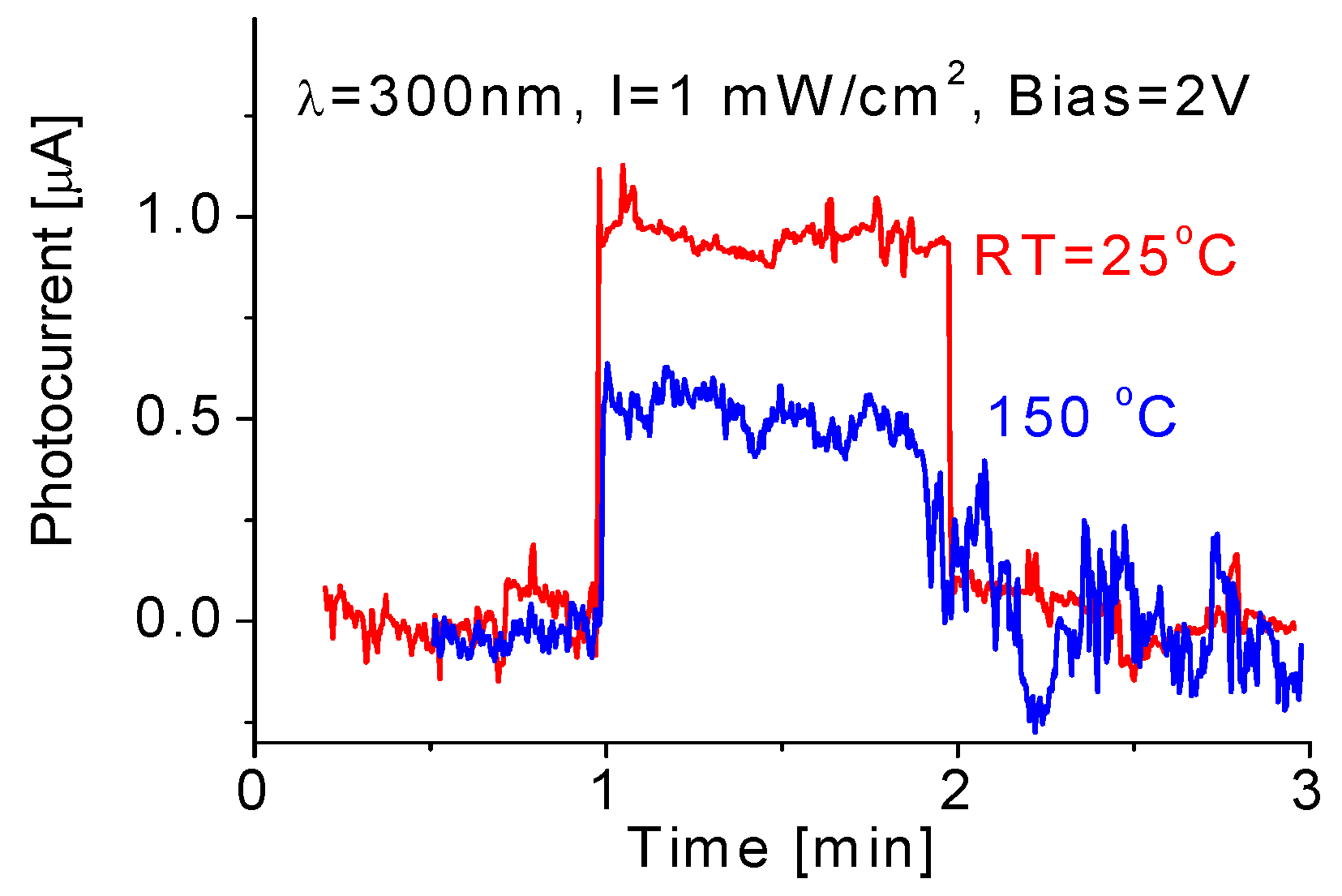
© 2020 by the authors. Licensee MDPI, Basel, Switzerland. This article is an open access article distributed under the terms and conditions of the Creative Commons Attribution (CC BY) license (http://creativecommons.org/licenses/by/4.0/).
Share and Cite
Aldalbahi, A.; Velázquez, R.; Zhou, A.F.; Rahaman, M.; Feng, P.X. Bandgap-Tuned 2D Boron Nitride/Tungsten Nitride Nanocomposites for Development of High-Performance Deep Ultraviolet Selective Photodetectors. Nanomaterials 2020, 10, 1433. https://doi.org/10.3390/nano10081433
Aldalbahi A, Velázquez R, Zhou AF, Rahaman M, Feng PX. Bandgap-Tuned 2D Boron Nitride/Tungsten Nitride Nanocomposites for Development of High-Performance Deep Ultraviolet Selective Photodetectors. Nanomaterials. 2020; 10(8):1433. https://doi.org/10.3390/nano10081433
Chicago/Turabian StyleAldalbahi, Ali, Rafael Velázquez, Andrew F. Zhou, Mostafizur Rahaman, and Peter X. Feng. 2020. "Bandgap-Tuned 2D Boron Nitride/Tungsten Nitride Nanocomposites for Development of High-Performance Deep Ultraviolet Selective Photodetectors" Nanomaterials 10, no. 8: 1433. https://doi.org/10.3390/nano10081433
APA StyleAldalbahi, A., Velázquez, R., Zhou, A. F., Rahaman, M., & Feng, P. X. (2020). Bandgap-Tuned 2D Boron Nitride/Tungsten Nitride Nanocomposites for Development of High-Performance Deep Ultraviolet Selective Photodetectors. Nanomaterials, 10(8), 1433. https://doi.org/10.3390/nano10081433







